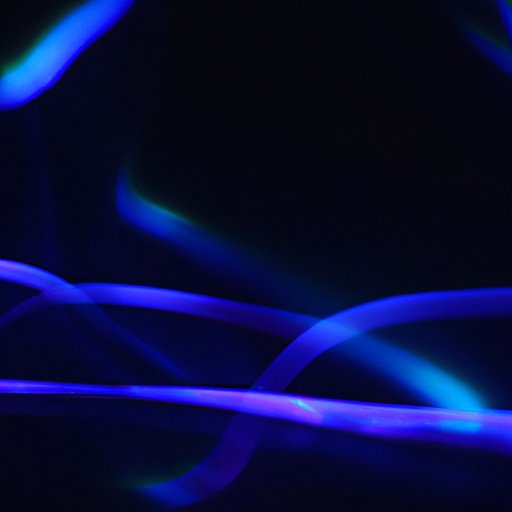Introduction
Light, a form of electromagnetic radiation, surrounds us, and we perceive it in various colors. Have you ever wondered what color of light has the shortest wavelength? This article will delve into the physics of light and how wavelengths determine color perception.
Understanding the science behind light and color perception holds practical significance in numerous fields, such as medicine, architecture, and engineering. This guide will take you through all you need to know about the different colors of light and their wavelengths.
Exploring the Physics behind the Colors of Light: Why Violet Has the Shortest Wavelength
Light waves are characterized by three properties: amplitude, frequency, and wavelength. Amplitude denotes the height of a wave, frequency refers to the number of waves passing through a given point in a second, and wavelength is the distance between the crests of two waves.
The electromagnetic spectrum is vast and encompasses all forms of electromagnetic radiation. Visible light occupies a small portion of this spectrum. Violet, blue, green, yellow, orange, and red are the colors of the visible spectrum. Wavelengths of radiation in the visible range correspond to different color perceptions.
The visible spectrum is between 400 and 700 nanometers. The shorter the wavelength, the higher the frequency of electromagnetic radiation. Moreover, each color of light has a characteristic wavelength, which scientists measure using nanometers (nm).
Violet color corresponds to the shortest wavelength (380-450 nm) of visible light. Red has the longest wavelength (620-750 nm), while the other colors fall in between.
Unlocking the Wavelength Secrets: Understanding Why Indigo and Violet Have the Shortest Wavelength
Our perception of colors corresponds to the wavelength of electromagnetic radiation. Our eyes contain three types of cones, namely red, green, and blue, that are responsible for interpreting different parts of the color spectrum. Color perception results from the combination of the signals sent by these cones.
Indigo and violet are both colors that are close to one another on the electromagnetic spectrum. However, some scientists argue that indigo is not a separate color but a shade of blue or purple. In the traditional seven-color spectrum, indigo occupies the space between blue and violet. Nevertheless, violet has a shorter wavelength than indigo and is closer to the invisible ultraviolet radiation.
Comparison of wavelengths between colors reveals that indigo occupies a range of 445-470 nm, while violet ranges from 380-450 nm. Therefore, violet light has a shorter wavelength than indigo.
Light Waves, Frequencies, and Colors: A Comprehensive Explanation of the Shortest Wavelength
Light waves, frequencies, and colors are interconnected and rely on the electromagnetic spectrum’s organization. The electromagnetic spectrum’s organization is based on the relationship between wavelength and frequency.
The visible light spectrum is organized based on how we perceive color, ranging from violet to red. Violet has the shortest wavelength and is associated with high-frequency waves, while red has the longest wavelength and corresponds to low-frequency waves.
The higher the frequency, the shorter the wavelength. Blue, indigo, and violet colors have the highest frequencies due to their shorter wavelengths. In contrast, colors like red and orange have longer wavelengths and lower frequencies.
The Science of Light: How Blue-Violet Light Holds the Key to the Shortest Wavelength
Blue-violet light has a wavelength of approximately 400 nanometers, resulting in the highest frequency of all visible colors. Furthermore, blue-violet light has the potential to emit high-energy photons, making it useful in practical applications.
Blue-violet light is fundamental for LED lighting technology due to its unique wavelength and frequency characteristics. LED (light-emitting diode) technology relies on blue-violet light to excite a phosphorous coating, which emits light of different colors. The phosphorous coating, when excited with blue-violet light, emits colors such as red, green, blue, and white. As a result, LED lighting is an energy-efficient and cost-effective way to produce different colors of light.
Understanding the Shortest Wavelength in the Spectrum of Visible Light: Why Violet Reigns Supreme
Violet is the color of light that has the shortest wavelength, ranging from 380-450 nm. Although indigo is close to violet on the electromagnetic spectrum, it has a longer wavelength than violet. Violet’s closeness to the invisible ultraviolet radiation further emphasizes its short wavelength.
Indigo sometimes gets considered as the shortest wavelength in the rainbow spectrum, but this is not accurate, as violet has a shorter wavelength. It is crucial to have a clear understanding of the electromagnetic spectrum, its colors, and the corresponding wavelengths to understand color perception better.
Conclusion
Understanding the physics of light, including wavelengths and frequencies, is essential. This knowledge helps inform the study of color perception and can translate to practical applications, such as medicine and engineering. Violet has the shortest wavelength of the visible colors and has significant potential for practical applications, such as LED lighting. Keep exploring to understand better the physics concepts that surround us every day.
